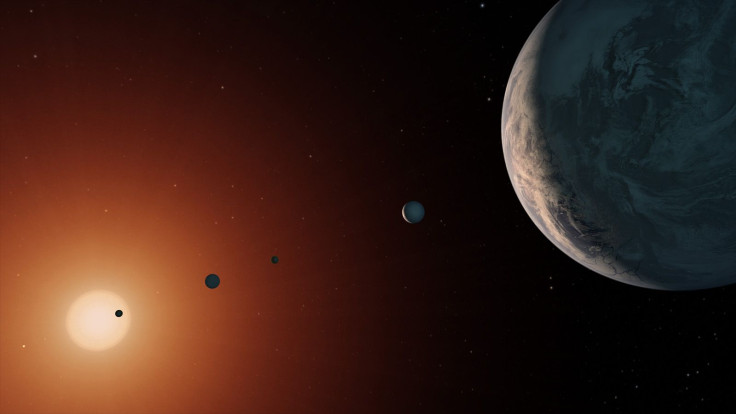Exoplanets In TRAPPIST-1 System Could Have Atmosphere, Support Alien Life

A new study has shown that the recently discovered TRAPPIST-1, red dwarf star around 40 light years from Earth with seven Earth-sized planets, could contain life.
Initially it was thought that the fascinating system, though estimated to contain water, could not contain life because TRAPPIST-1 might be a very active star that shoots out flares for millions of kilometres, and the planets around it, even if they did have an atmosphere, would lose it.
The TRAPPIST-1 star is much more active than our yellow sun. In fact, it is so prone to solar flares and stellar winds that it would obliterate any trace of an atmosphere in the planets that revolve around it.
"Because of the onslaught by the star's radiation, our results suggest the atmosphere on planets in the TRAPPIST-1 system would largely be destroyed," Avi Loeb, scientists studying the system was quoted as saying in a Space report from July.
But now, a study by Princeton University and Howard University has shown that the Trappist-1 star system might be able to host life after all. The study estimates that the planets farthest from the small star could easily retain an atmosphere dense enough to keep out harmful radiation and could support life as a result.
The seven planets in the Trappist-1 system are all very close together. The farthest planet, 1g, is only 5.5 million miles away from the star which can shoot out flares that could easily reach this planet. Each planet in the system is estimated to be only a quarter-of-a-million-miles away from each other making it a much more compact system than our comparatively vast solar system.
TRAPPIST-1 is a very dim star and its brightness is approximately 2000 times lesser than our Sun. Earlier data accumulated by Hubble Space Telescope showed life around Trappist-1 is possible.
An earlier study also indicated that the system could contain water. The study found that the planets around Trappist-1 were temperate which pointed the team to the possibility of water there.
Even the temperatures of these planets were estimated to be pretty close to Earth and are estimated to have greenhouse gases. The Trappist-1 star system is only 40 light years away from Earth
According to the scientists, the main question for the new study was the planets’ ability to hold their atmosphere despite the stellar winds and flares. Researchers concluded that the outer planets of the star system are capable of holding their atmosphere for the past billion years because the last 3 planets fell in the habitable range.
The two outermost planets named TRAPPIST-1g and TRAPPIST-1h were estimated to have a high likelihood of holding on to an atmosphere because it's one of the three planets in that is in the solar system's habitable zone.
"For thousands of years, people have wondered, are there other planets like Earth out there? Do any support life?" said Sara Seager, astrophysicist and planetary scientist at MIT. "Now we have a bunch of planets that are accessible for further study to try to start to answer these ancient questions."
"If these planets have atmospheres, the James Webb Space Telescope will be the key to unlocking their secrets," said Doug Hudgins, Exoplanet Program Scientist at NASA Headquarters in Washington. "In the meantime, NASA’s missions like Spitzer, Hubble, and Kepler are following up on these planets."
This discovery could fuel speculation that has surrounded this distant system since it's discovery: Could there be alien life forms there? For a planet that is very close to the size of earth, with water and now a probable atmosphere with greenhouse gases, it has all the right ingredients to support life.
"The presence of an atmosphere over sufficiently long timescales is widely perceived as one of the most prominent criteria associated with planetary surface habitability," the PNAS study said. The study also added that the probability of the planet already supporting life is plausible, but still at a very speculative stage. This can only be proved when we visit the planet and collect samples and test it for microbes.
The latest study was published in the journal Proceedings of the National Academy of Sciences of the Unites States of America on Dec. 4, 2017.
© Copyright IBTimes 2025. All rights reserved.




















